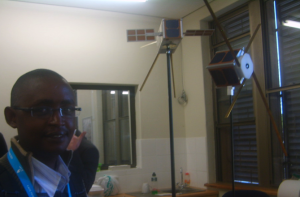By Ivan, Ethan and Jean Pierre

(Sitting from left to right) Jean Pierre, Ivan and Ethan with Dr. Michel Verstraete (standing) – one of the workshop’s organizers.
Three friends meet again for the first time since they first met in 2010 during the ESAVANA January Term course in Virginia. They have travelled a combined 79 hours, but this time in Cape Town, South Africa.
Ivan travelled 41 hours by way of St. Louis, Chicago, Abu Dhabi and Johannesburg from Southern Illinois University Carbondale, Illinois. Ethan was fortunate to score a more direct route (about 26 hours) from the University of Virginia by way of a direct flight from Washington, D.C. to Johannesburg, with a short connection to Cape Town. Jean Pierre had an interesting 12 hour journey from Rwanda, first flying north out of Kigali to Addis Ababa, then back south to Johannesburg and eventually on to Cape Town.
The three friends, originally from three different corners of the globe – Ivan from Maputo, Moçambique; Ethan from Roanoke, Virginia; and Jean Pierre from Kigali, Rwanda – have come together again to participate in the first ever SANSA-COSPAR workshop for Advanced Land Surface Characterization sponsored by the South African National Space Agency (SANSA) and the International Committee for Science’s Committee on Space Research (COSPAR).
They are all here to expand their knowledge and familiarity with remote sensing techniques and tools. They have had an exciting first week of the workshop, sitting in on lectures focusing on everything from satellite fire detection and land surface characterization to the global monitoring necessities of climate change research.
Jean Pierre in front of CPUT’s Cube Satellite Prototypes
The workshop takes place at the picturesque Cape Peninsula University of Technology (CPUT), a fitting venue, as they are a leading institution in satellite technology. They were even able to tour the lab where CPUT built several cube satellites that will be launched into space in the near future. Their studies are particularly focusing on the applications of data collected by the MISR (multiangle imaging spectroradiometer) and MODIS (moderate resolution imaging spectroradiometer) instruments mounted on the Terra satellite.
Stay tuned for more updates!
– Ivan Remane, Ethan Heil, and Jean Pierre Hitimana
